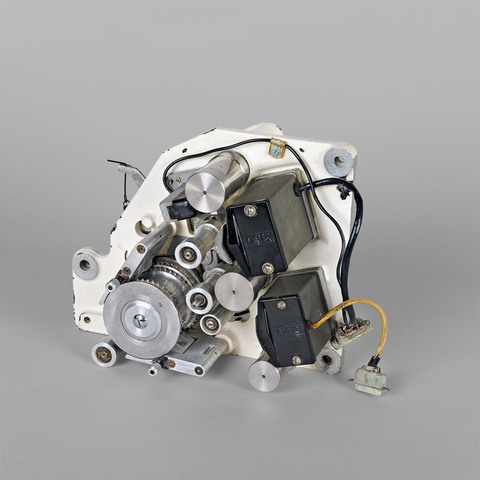Lecteur de son magnétique
Fiche détaillée
Type de l'appareil
lecteur de son magnétique Ampex CinemaScope 35 et 55 mm ; un débiteur denté 35 et 55 mm ; deux têtes magnétiques quatre pistes Ampex ; quatre galets ; deux presseurs
Auteurs
Informations non disponibles
Fabricants
Ampex Corporation
Redwood City, Californie
Utilisateurs
Informations non disponibles
Distributeurs
Twentieth Century Fox
Los Angeles
Sujet du modèle
Informations non disponibles
Objectif
Informations non disponibles
Taille de l'objet
Ouvert :
Informations non disponibles
Fermé :
Longueur : 26 cm
Largeur : 20.5 cm
Hauteur : 21 cm
Diamètre :
Informations non disponibles
Taille de la boîte de transport
Informations non disponibles
Remarques
Marque "Ampex Corporation".
"CinemaScope 55. When Todd-AO proved to be a money maker with Oklahoma ! and other wide gauge systems (or variations of Todd-AO) began development at other studios, 20th Century-Fox decided it was time to create a new roadshow format of their own. CinemaScope had been successfull, at first, but had not defeated television. Cinerama and Todd-AO were drawing big audiences, and the next step for 20th Century-Fox was the logical one : wide gauge, wide format. The old Mitchell Grandeur cameras were pulled from storage and revamped for the new "CinemaScope 4 x 35", as it was to be called. In actuality the system was the same as 35 mm CinemaScope except it was four times the negative size, photographied on 55 mm film made specially by Eastman Kodak. The perfs were the same, as were the aspect ratio and the four-track MagOptical Stereophonic Sound. Studio executives were determined the system would be adoptable by any 35 mm CinemaScope theater by a few simple changes to existing projectors. While it was necessary for bausch & Limb to manufacture new camera lenses, the standard anamorphic projection units were usable. The idea was eventually to change the sound system from four-channel to to six channel-stereophonic, but that would be sometime in the future. CinemaScope 4 x 35 was renamed CinemaScope 55 and put to use on Carousel (1956). Twentieth Century-Fox wasn't sure about optically converting the 55 mm to 35 mm and had the film shot simultaneously in CinemaScope. Midway through production the 35 mm unit was disbanded and the feature completed entirely in 55 mm. The optical reduction had been worked out and rendered a sharp, clear 35 mm 'scope edition. The King and I (1956) was shooting in CinemaScope 55, and The Greatest Story Ever Told was announced to follow, along with other roadshows. Upon its completion, Carousel was trade-screened in 35 mm and then released only in that format. Studio executives felt the 35 mm reduction was so superior to regular CinemaScope that it was not necessary to make actual 55 mm release prints. The King and I, however, would be issued in both 55 mm and 35 mm roadshow versions. De Lux Tour, a short, was shot in 55 mm, shown in one Bronx theater in 1957, and shelved until the 1960s when it would be screened, with new narration, in 35 mm only. The Greatest Story Ever Told was shelved for the time being. Despite the huge financial success of Carousel and The King and I, 20th Century-Fox did not follow with other features in CinemaScope 55. The process died. Nevertheless, it was an extremely impressive system and actually clearer, shaper and wider (when decompressed) than 70 mm. Twentieth Century-Fox had built new cameras, and the Bausch & Lomb lenses were superior to existing anamorphic units. Like other studios, however, 20th Century-Fox decided on 70 mm as the best wide gauge format. Future Roadshows from the studio would utilize Todd-AO. Interestingly, The King and I would be reissued as as roadshows in 1961, optically converted to spherical 70 mm and advertised in Grandeur 70 with six-track stereophonic sound. [...] Today CinemaScope 55 is a forgotten process. Existing prints of Carousel and The King and I no longer bear the attrative logo which originally introduced them "A CinemaScope Picture in CinemaScope 55". The 55 mm preprint on both films has either been destroyed or has deteriorated to the point of unsalvageability. Even the 70 mm preprint on The King and I has turned purple. Fortunately, the pristine 35 mm reduction material for both films with the original stereophonic sound has been saved" (Robert E. Carr and R.M. Hayes, Wide Screen Movies, A History and Filmography of Wide Gauge Filmmaking, Jefferson, North Carolina and London, McFarland & Company, 1988, p. 65-67).
Bibliographie
Robert E. Carr and R.M. Hayes, Wide Screen Movies, A History and Filmography of Wide Gauge Filmmaking, Jefferson, North Carolina and London, McFarland & Company, 1988, p. 65-67.
